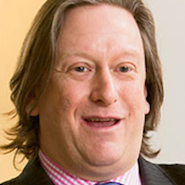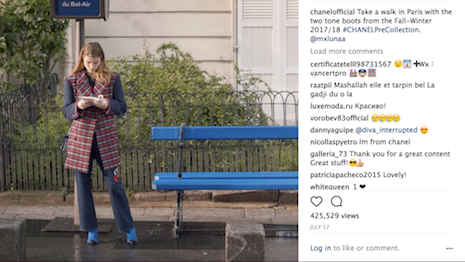By Doug Gollan
Social media is a top conversation in the executive offices of every luxury brand these days. After all, social media from Facebook to Twitter and Instagram reach not just millions, but hundreds of millions of consumers on a daily basis.
Consumers continue to spend more time on social media, both at their desks and on their smartphones. One could even say without Twitter, Hillary Clinton would probably have been president, and Donald Trump may not have even been the Republican Party nominee.
Of course, for President Trump and most luxury brands, social media is a mass-market strategy – a cost-effective way to reach as many people as possible.
Billions served
Corporate social media and highly choreographed influencer strategies have made social media a subject where there is much focus even if the jury is still out as to exactly where it fits in the sales funnel.
On the other hand, brands still struggle with how to get a bigger share of wallet from ultra-high-net-worth (UHNW) consumers.
While there are only slightly more than 200,000 households that fit into the most used definition – $30 million-plus net worth – various research surveys show they control as much as $50 trillion in wealth.
Indeed, their total wealth is more than the GDP of the United States, China, Japan, Germany, France, the United Kingdom and India combined. They spend more than $230 billion on luxury products and services, per Wealth-X.
In other words, while the UHNW represent less than 2 percent of the world’s high-net-worth households – $1 million-plus net worth – they account for about 20 percent of all luxury spending.
Finding UHNW customers can be difficult.
Event marketing is hit or miss, and many events meant to target the super rich end up with the sponsor simply serving Champagne to a good-looking crowd that does not have the wallet power to pull the trigger on expensive watches, jewelry, fashion or automobiles, let alone shell out $2,500 or more per night for a hotel suite.
UHNW, who typically earn more than $1 million per year, make up a very small sliver of most print magazine circulation from all the research I have seen, mainly in the low single digits.
Web sites are another challenge if you are trying to reach the super rich. Research I conducted with private jet owners showed only 15 percent of private jet owners visit luxury lifestyle Web sites.
There is a smattering of enthusiast media, as you would expect. After all, UHNW have diverse interests from collecting watches, art and cars to yachting, diving, hunting, running marathons, the opera, ballet, extreme sports and following their favorite pro sports teams where they plunk out hundreds of thousands of dollars for courtside season tickets and luxury boxes.
However, 85 percent say online and print media consumption revolves around business-to-business media in the industries where they own or manage businesses that create their wealth.
In farming, there are about a half-dozen trade media just for dairy farmers. Other types of farmers have their own trade sites. Car dealers have their own assortment of trade media, as does every industry where an entrepreneur can make a fortune.
This, of course, brings us to social media, where conventional wisdom is that the super rich are not on social media as consumers of the media.
This viewpoint, I believe, is because many luxury marketers still associate the super rich with celebrities and high-profile CEOs such as Michael Bloomberg or Warren Buffett, whereas many of the UHNW are what I call “Driveway Celebrities.” You could walk past many of them, and not they are worth in the hundreds of millions of dollars.
In other words, the only place most UHNW are recognized is within their inner circles and industries.
That said, while outside of collectors, the UHNW may not have the same passion and deep knowledge of luxury products and services that aspirational consumers do, they certainly consume a large share. This means developing effective communications strategies around the segment is critical.
Will it fly?
In writing about luxury travel agents who serve billionaires and their less rich centimillionaire cousins, social media actual drives direct business.
These agents spend a lot of their time scouting out new hotels and resorts for their well-heeled clients and as they travel to far-flung destinations, post pictures of lavish suites and villas. In return, they get text messages sometimes as brief as, “Wow. Looks great. When should I go? Can you book it for me?” The result could be a $100,000 sale.
One Turkish jeweler who observed an UHNW in Taiwan posting several images of jewelry she owned tagged one of his pieces to her. She bought it. The piece was $60,000, so no small sale with zero in marketing investment.
As a point of interest, some of these agents I mentioned only have a few hundred followers. They just happen to be loyal UHNW clients who look to their agent for advice.
Obviously, getting UHNWs to pay attention to your posts on social media is hard. It is not as easy as paying a blogger with a million followers to post some images of your product since the super rich do not really follow these so-called influencers.
More important is thinking about ways to get their friends and family to incorporate your product into a post.
One clever example is by Lufthansa where its First Class Terminal and Lounges make the social media feeds of even the UHNWs who are charmed by its cute Lufthansa rubber ducks placed in the bathtubs and shower areas.
To continue the snapping, Lufthansa created a collection with themed ducks for Christmas, Easter, Octoberfest and other holidays with ducks in appropriate dress.
Since UHNWs on social media are most likely to follow family, friends and people they trust like their travel agents, a simple plastic duck has served as a great promotional tour for this luxury experience.
THAT SAID, I am amazed at how many times I hear the statements such as, “The super rich don’t use social media.”
 Doug Gollan
Doug Gollan
Doug Gollan is New York-based editor in chief of DG Amazing Experiences and PrivateJetCardComparisons.com, and author of “Secrets of Selling to the Super Rich.” Reach him at [email protected].
{"ct":"VpGc6F2k44XFbJkIkCHLsJJc+APYtnjbgEk4UkQ19YlTM0e60OelZKGUDGoU+QoDWqc6AWjhaWNm7Ilz8IDttrHgQiO2kWOvzldPrEY7YAZnaIxwlp4eIROj14J6\/AmyoLdToA4+vI\/5dLS\/3oAZ+T0FBY09e2Fd8iP6GaNyr1znuwUjqzO1L8sMEPqPpAXd6gShlDk5F531oRVTt+YgpiHWCtAhVqyUkHH\/dw+2jdBeawTFh0XzebAf0WdBVDkXc0CpsWhCXCCjNFUmLF4OWV9TLpJvVu3UHdnukqpdMBe7V7jNIQmORyJ1SqH++K6rUeES97TzYU0JBnMtB5BDrMbsu9WctCUnROYAeelf6Chqbnrz6hG41GmH6BwMmPEYTWl5hmDThz\/WblAQGHUXhjD4f5DwHcXYMnJJqTWGNbgBdTvaZ0j5FkFPhlWq8CkjUwBif+a308k7Sv5Amq4crdWiIhA+kMQumTKGZALwulCQC71NF5X7447F7Gu\/qw3XafOrKgFtu62mkPwpuIvmU+J8ij9D0tnxKVVgfpbCLGvB1yyugBIb+UetEXtvSBMyRwuANLm6f46DhbB6iaoFhujim7gM2Mnv27tF2MM3+w1NfpDak8umMYcHRxffICf3m5fD7reoR\/yVvKc\/FWRzfImEjnpHdCF\/SXcXgiLfOS+dbiwkRGa0zP3nJ2ku7FcSQe4GVtDBIXHXLYcvEoUEnKXIE7dn1N6u9yKHmaLRQIhQn\/FgO4x0EJOlKSU1urjvwrrAOWqkWhTMtWL2f\/aobo6HgQ0e6WU3RzU1UfrBI7KLe5B66q\/obCf0IN\/s+PibpJ+F2M7q+bcAn8UBDi0wlGXFdHZfet6Ms3d\/bGoD48bStT8P7teRoKkUItYVSDQidnr9T+7tHvdRyBCypMDjX4falE8TWRLAc4EfVmzmDaJ5J1jDqZHVfeO\/Nq0+aqFCoWImfiHDDPzk0LiIw7H5\/c4AFwEQ4tYmr\/tT88pOz+cHG2HYf09MEbO4hcFDEMdT7L0p0\/AeWdyGNH056RNkmrncj\/xcRnD46uekMMsklG4um9CWXPRoMfgvGI0X3HnF7oYWmkXxYoDEC3fEMUgjFARw0bFH07MxNmZ4FBt8WdI7rvYWi6I2dr3kjA9Yrywm0wHrfNu6NLagcQmiAtl+CKZ+INRrSmuY9d+KEP6WiM62UsrWn3NRwvMTnAbWZgr5t2xDyF0U1gkm3z9u7KP94xCiUuB\/EvkYaVE+PNa43zjjMEjb2f1Kw1kJsR9kgEcid3Czciy\/GKekKaX3CnI1txB3ZRikMUACbprVdKLa5EV8+jfruxm6es2h6PmuScZn3qZ9FGDouo+3RrRpLLWNjiSMIGkZICI7EDV9UDMPt1DOxcbl64TCAehLkfBzjYrEn\/iVGMNCmyzqT4r+M68Lw9L9YeLqzBA3Tdcd\/y\/JT+asJZ7yEfSEHIcjKp7XPPl3VNWx0i9pNbaqzFqCziu6KCQUTEMZNi4+2g7K7fD0pRIDj2Gjozr2TDjBWzkVeaa0ef9p6bVljfCM4Psw4xXcOF1szSxKPwh\/53ViZpj28nFoF0Ukfx9NCA5Q3wt1hBjbURjxPbrn6kn4JcQaSunykoBPFHXwETtVjTVRnKvE8qgwZQX9FIkFFbgGFgGlYFMwKFnotY7d73ScKId3UroRk7eVg5Pxl6LgKkff1B5xNL0yB7sRBaMUJfRt7B4os\/Bp1MmiYOIJvEOmjzdtDNlfj+Sem03VKfARBZTl01GLhTDmNJ4ouh8PufG+aO\/ZFSRJ06kJGgUKY1RozW91i0gankTmtYfz\/BJ8vX5HVJmq9RbsWQ7T1GFDf0qN7Y5pyofa2wlBan\/bNjM\/AUzyNCVZaO3v5LibzolHqVu7\/oUXV\/HVPAfY7PncoezFsrnw47F0bGYOqHOfg+I\/EQmUc8zVqOMs4yS0fEFTkQqObvig9xDvk8RE94kVHKF2xcCJiYdETxq0Bg1mM2SNtV+iKmB4NgRIyJsqVA7RmoWq238uUpcl6PReZLZ4X2nuFRC8LIuxNK\/Cb70psIqsuOkXKo3aFQZqo0\/KTqFcKiP+ltRcQpHZJmviOhb+UDLjMqHE93rX0zbqyVnn3o6CcLciXn0HukSCNw7pgMYZx+P\/EuAXJhK3LVT4SIeERP2pSU9N0gIfC9ELZWZ390xxmyh9AFVvp\/8f2t2ws\/TvxkyApCb00PEFSb24aHkvUet\/bNXSQKnxVDzeDiZvRBVIFRAI3MJbDxwUBIAxnJFzqujOc4FpuNvKZZSNTyyX1O8\/EQdILtkKm7Eg5dy1twj3u505TRXJbGtQbWTriq9I6vsAK8SkUNyjmwVM4JQ+EoUTCGNT6DL0T14kgN3+hps\/RAe6MBLTVFXFxWqSEZL4AnUjODIho2SI8yQjGv3CJzjkrAp2ypXlBRgu1i8dTBiDqKqk9\/c8TDcIF+iPTcUoXn+hfXLezBYbISkT7\/B\/YzN9oVj9dopqxfRnYktox4OCfc5u1CXLTrME3t8qAc25jB\/K9+gJ4G\/+In7XySqHGPmsZYWKFNfLXTRKQW3sabUfHU10WFE4doD3FgMUtVjkR+MNymJrDlT16wKtpiWssn82uldoIwkE\/ovEPdOS8DUkLl71BwyOfRFtqxYrdaonjHKbWi4W+NyhnhnsNfkA9FBxCoHnqF+aQ4bFW8icV5Zo7yq6CuU8ZA0BI7I2KCFuU6JAEuWfLthwkuaEPLP49z8E\/8Ua7JN2AgHin7la3nwd+wffqhwx+9USp4KgG0aAWtMcTY6t\/SsEw4v5ekbdXZ4cz+2rzf1KFIK2So09TJLaPU8g8dPHUSR5uy6OnTb+WKYFvG9tSEqw1zGn2h\/R8vswLp93IcUbCa6hKA0dOCYl1U3DeqIuskd2MqQJnZT\/Vbm9Dxy\/V5zpVkWjgw3iFXJ62HfeA+s46wVDblZKbg9l\/Nla3PLHGpfv0xmWUmvmgOZxgHE1x5gvq\/Mem1yXTjxPXoPBmhIjcDYRiOCIks2cRzc+eDgW8zuzC8xaty+YwiXNEEfWo6vBeAIRud\/aPW1NoRXqhxxp+6d7uX1jp1NHihMzHOo5ZCoZPYTAd4JqvaUECl01zBwviYqd1NERYAse3fuv5wQilOUhNwsAQMXcAm4a2fGW2GLpbmybn97zkP3fNnOrBWDYLhqf8Yc6BQghy2CmtVnne8Iy7mM8j7diSh8OALsCDs\/UPo\/Z2d1ZnFIijTHyy7\/ygJLteSvgxahTj\/0oRgt56n1VH1yUlOqwdT6cgr19c4DasnL03f4z5D6TcsTBd9lM4ocym7EIhtMfJrm9DyHw+ci3Sw8pxp2l1VcTRoMQ\/abJPxOPqVL9AGrKzHKP0m1rpMemBXZWwqWaLMPu78EOqeizfN5T4I6ueqPBUHPcOtXWgpvIUkloxT9oPEClB7m8Vyg7XW66pWumXtypwBokOcuHlJofpqGim+UFv+aiNiU0wDdlIvDnIpTKagG8jWQ42ptd5skcy\/OaPF5k1Kx7LJtJRkJTqnM+CJQVzq0UzOiklRs0d5D\/ro+65surXiiGuufx7PX2z\/rdQ8Z7+3u9SSJH2CS8cbtPNV7Zca\/1Ef\/Ab1q\/5OeOB6araK7BfjmkvqkZj5OwVFjzwyiO8pe6IAxkAIYR+SiZlJ2CVuOUr8suHqfIJT+gv6xsJ1f3nC3aEHrqUAv7q5u9parYWeHDWBE71IUO3XAzRnGLmDOHm1j8glng+tlK5V9SPe0Pi\/5wNIRlhwCHrODKrP97RWqPF3d9b\/oKNQllJBBiL6LvnLajBMtsJhWK5DI9r1E9TsB1ebTzTesAhzxsZfLj0MvgIhAGuOXWLgXIVyedhABsEoE31dlgOsKlMLBKDEMblyNkOIxTA4iNvpH9nUYVdXqtyDOMywgCboImoEZ84IGZmaW8tmkunenBRNjIIHEb4mDBzPHROM34PWI\/q2aNf7hzZq\/43fYFzJw3E1rzEhIa061TPTLtxXoda1QEtXhlmwRKUhvfR0byuyO2M+Guwf8HdSUjiEfoQxslBZfH8AruHSNmWPTobac\/Xw5wDJenfI8Zf1uiDTuSKxjfsXhIfZloqe+rVEOhsd0cht5JLr4CWKgOydvDvEttNAnU6Q5897c7niFHK0b0B1GjKAyHIR3saCuwfOV9voUjrOoxPT11IvGiAqRP+MZg9lP+zpnmCkUrsz6XfvHl8bL6tW4DjwSumkBHDFqF16GTd8fK2LtS9TXoIwbyexETuW0Bzd5F+1vZVKL\/fOqgjvY9I6dT06pu41fDi4NyzhBTNtgLU\/Bccq9Tb3WK4cRDdlKsbJLtyqdwsQQZtQRUGR4FgJmaSxX2h8pkPkqGYy6vvrhWAJQ\/siDhL\/a6lsepKWsgRbxleHXu4CAoAO0TeK3R0DyoWG1xVg1d\/m6LQdJfO61BBeVe7O3lWJO2DFGs6WEZLvXpv2Xb9EaOLar1BmjJNo6qZ9fRKe3DL1d4Rx5EiD8ZBFtIgTdYhBElPyVgQn59I2fiM7mr0g9Qb94nJdB5KjSd94nTWkmY1EpPHixo3rtjcjOWd\/P61iEoa9DG6LQ\/pHkrCwi9SMnAQSuq0BGKu92wBSz9QCFFTvQVOifHPx\/Qv3gqLEVBKAAHVrOzEyT9ZB6YYhgnKa5Fh3jzGjkYIy1IKPx2fXBk6A4\/mEs9jvt9\/LcAE418\/mnQN5lu4JKWzqSUGBQpcK5g59AMA4aIkCXZpKdHSgC\/n0AHcwiRI6hLFjgSlywBq0rXMQPcXQarMD8I8jC6IXBdL5cheMjcRiXGeNi0opExQMM0K6+tfKS9TtGL+BuzxHxvVLxa38k8n8elg3TXK0WkyeyU8CeKhJwiezX4EOzUhi59Mwsmbt7QFCYXwZBw1BLhzFXpUwSAr9QSndT9e3eyJhkwC\/1Qwjll7ODvAHm+7P2aJ0uqCkytCtR4twDJerfppbDlhbHEKFeEvrYDbEiw1\/qwbAuAPqgr1FgyJJXKfIoIz0q\/EWx6Ab7almsnOkBZ2sfde71AItoHFc\/Jpf85i+589KFKYhMTCFeo+6s7hlRUHFv+ZNfRb5chqbBN2lm8Y9ohOtpyF\/x44j29dfcGXBz25eIHWMHJY0Ny4gYAs78opimLS3wLonbv8hrLOYvcuxdR20YrZrgMjIZM4Zu18AxkGmKE\/44qBnXuBkBORQpZSWHf0I8CVfTZfOS3ChgGuBG\/hFYbUjaX5WLW87z+Mw86Xif4Ih0+SkpKY2GknpWCe0EErjhc1tjsRZmTXbqle3bUSJFGyvAoMbU7RUJ8t+qhAyzn3uIhLA1S5gGypDHml0psaVI1kgvWuEnTfSI8StkKvZM6xpkGk+6elJgq+GAu61TWZ1m3ujIphosBwDhrID\/CfCpeFv6qUfNHrV+G0C\/cyFox0JUhprYmVQR3pyGHJROFTqte5srPLzUCsYmaifkht9cO81fNO05yqxfnzGHMSrrLlMOsE4KDlv0Li8rR8iv0G7\/x61PYTtWuLb0pr5yz\/6Ua2Oifz8a0dj9IxHG6fGTXLQk6JzonvDVBAGIAbA50MnJqR1Bs0l1felFs6GVZ4I6DyDHZgEHMnLpHtrIvyW1S13zd2u53bGfU9YtMcl5czwLItcNW\/g6gdX7GQoP6ZeSPXZDOxX1wlSBstLv67JwDkppuzVy7PilflHH6Vl2\/ZHPFyEapytoRDCSTJ9tGqLRBc6GVRumljR++13TGwAw\/x21RShxiIg7B3rPw7ty3hSMnYxSbRjK3Ns7xlVpElG+DsSfyF+HIZ0iOjVYqqHmiFbQgkD2QYLJe4fpg8Vio\/LILizl6JivP3diOHPan9ruYdme0iw9Fdh3DJKo1wTQEtfzMwCeEZbsQ\/YAITlF99IAB3wzDDT5binXfcWTX3\/Zj+YFs6gYRUzXycSme2I5penK+DhE2Ef5kpmEs6tLzcaQ2R1dJxiljHuuigsPZkttPw1RdWA0x6p53xqNeeHNg8M7DA55vttmm\/sXi8pS+MiTwYilRgtSKqOf+pO2hCMCmZ1z3JT3myg2BAh1lwoB0x4s0GXOh3XsGPuoz2adC6910\/Gd20XnxA9sosGzlsk7prPCWj+pBhSHRFeA4BJ14YXFAG6cCVwU0qbMsCpZtfpGkjcVF1mLyIzriAJs87vbopSn3xyWPvo3+hL27jAo9Bt15QNY2PiMV7gZ\/IhyBm0eVONcGrJowkrtrF3l+DJidAOoGm5wanaS6aMuniUYZiUqIn+TxBZYu9oA0yFB87jwBeylpfKHtG4swIx5\/ZdeGovqWXSGboda8v5pX8TMpngqyzk2A80pgSeImIebs+1pe7f4YnJ\/4H5R8vY\/bfroO9Xs8Vc4aLo6LiE+X46NO+Hjiv9MrkzyKQ\/1MCrtPfxQiqsOm3gQx6mTg4odv\/SCkmun0z64KYoAjvHakp\/wqUXWhbID\/L4QsqMOEK0QVAoLCymUEQIlt0ki1+DlTzHJqhnaiHlp0STlWa7y0Dw\/meXTn8oEX1CtZpF327UmEei7irEXMhNniB5B8b94NXaSlfrzLJH6W4oZ1TC4mjxJ9WBdzPdpz++m6w4Tklv96LE7m1KEdtHX3rImPZRe6k8Q5\/YJVugv3u+ikEANiVO5vR249rMp5VOC6YpDeWhPkA5vDytxrdXq2pJL9zHvkYfr4op2lciodn9Ws23U2xbn5xuIdvM9VyEk5o5HMJlTuD5tvGoUdKm6KB8d78bhfELoP5vyPfMZFFH8K4Iy3wKTBg1Cvw7mpGE7UE0bvY3oVOOO8Nb\/xCkkhT+5QVsmnJIk6oOqdm1dguLuNXTxSeR9QszX9ACRkrkS\/e\/RwR2+3tc0VvdDOfu36P8psxkrMIM3YjXv7r5st9fwcaasz4hYpmzLAopM\/QH\/v\/gGYqHU+og2DMwoDCfN\/TmuGqLBPkwH1m0XU5rz9iy7xxEcEgm3Zhs0BpTmbE0M5lZ1ohbo69XOY\/VJfqZY5NuDeq39nf6WnzKU8FS5RYAgTOHIdEQG6OK3mgkyYCuxkJj3CUXhwd4Lqz+uFWwbNbY2uRVDPqnJUuiWpUBg5kTvsKnVbA9k6KDu2QlzOda1CsgyaiGOtITnWHW+tt\/YQnMwh93DzE0I0ljGEt\/j0t4xLT3B5O67ticYiE144W4wRxV50kDJj2YiRI6RCa6hx4r89RJ3tLl+fp+5\/6td\/PdtY7nTZ2jttscFKO6+wCj1SXahwWQo5Wq36cSZHPV1SoYS2o4ICx8w26PVL\/FzwDu24WfjDbWpm5iMiqBG63Ci1cOPO7MXHvHlNSKsxwJDXXE89pZRvO\/xZlTd2nvxSPXQkQ\/VzGu6U\/snAbBbQuneEdaZuawx3t\/t2ffzAIsAHs1xZ+rDHx6k174AZo3o+JC0b6HVJ8EC2ivmDyb2B1Oobsk4QLs4uazkS2Q4iPFGH+rzJ45i9X\/epi5ZCm+jDW4x36k2XWS1W6tz2ZSRXb\/1kH\/tP\/kTKfHFZIjOTxHAncV92DL9sTHUnsTPOWQVoKu6PBIIvmeeec\/UOmOJG9wWzQa2whSfALzVOME9uidCObWY\/6lC7eaj9qyIWfk3TWRuqjh8BguLHexruJ+QF\/yyAgBtn2DZtnhsW5rpP7U9CQ3QstKZKE93uKsQKXuJjRTWR5MeEkT9ib\/CNASMFxJex0DwlScTI3qH6qdPoHFXUyb0UBARgrlV2D9LAcreRHG7maU2ZO+fFDqdl\/88jUF\/wk9jQo38SHLECvtbwV73ytJv9fEaAjEYXpBHvx+QrFDRAR8fTB1hnzdPe2pySX25pdZCctlP2WaD9oZJM\/r+eMBfb+u+VoIg7Dj\/AraFkxs9mr\/l9jJvsxrCajyNz6XhsiHVp35aq4fzQEexdWXNjxJbjrW0FTVhf659yLn8XRiuF0Irbr+jSjDkQDDPcXZdpX7dijPkVoDNETFvAXbhoa5rAjKfEHXN8t\/PVzxGUtjzQkAy9a3GHgX6\/cVTSebjKfNcr6lH323iBMqn5aT5IQTrpO\/KztTySVeL2QniGPHv9JrsQGFOuir9naa\/PtDY6r2yoj6rzcum8dnoeFz\/6ZigoDBphReRW9jZLoH3KA1CFJWLZlPsHFUK1HDlnsrAH6wZLyt+19L76oN14vv+hKHA6RDUlGXi1CxmQiFcGJVmFF2cVbEuZP6AlgG9Xip\/FxqWl6LnRcg43Stw4fikloomZOFmWVg7ja16YrGLSErbE\/kfvtSFkS1Ygc+EfG0Th5ZJFO\/P2EjqxGkFhWdQ+gaXvEO5HKIPJO6Rq3XUdIo5CpI1dTvIbDFZQxcW6XPT9xN2o9fFT1W5aKdS6VoD\/jQhWEOBM2UDlVW0136NDLiEIegdRPSAVa6PJWq6ZqynZ9rbqrXSnPH1oIvvPhtE+RPMr+ljLJ+pgAgP4mvKlmCm+uSizcuqYjZE\/afY9yqzlW1YWaXtrtHXaXrO42J6qbssZgMSlVQ9lCjEzdBXTA+5VpJAy5\/qd9cViAaXqqsLL0DAi91HK67NBrYaeuV6EJ4hh+ahGu6l39pGT902XVW4qYmgI38VEyQbksjm4Orqr7ubR\/cNUb34YEa6wFNgTHVd0pQMHVpQi\/hHXEloH4eUnZGEP6o9TkwzLWlqknexur2lV5mt8LThxudcCPJQMKRJdy2ZLM\/FbcQikdDuLy37uOqvju6gc\/WDjlRB+cNnf+fHEhU3hUztQYBdY9jcAVVU7FPg0L0aF0ikJQcxGGksiTBbLy1fK5lSqid20QbMbvfbBzTy9k2K5yRPvNnNkWcNFM4VdQzeJY+Bd9M1I2DvWDO9q5ewfaHoB1RJVGgfYrjVjQdZa8g4VhCMcbcEnBj8ctCXpO2l8lSJeKjMBtWMt1HOXEsyojrNDuWasn7Rh8XobNqbPl3KnQWPdPBD3ZeWzC90NW62RiwEG23d8T0fxBH5X3Hoim3q4yFB3hDIozEAkBcoecZ4NXQVBAa68actNS5ztiT5HDTaDhII501I61Dy1POFnBXaznAvO39XCbFrL72jH0GmA7lU650BFM+ATaufiBKtUpnBO5R+4LG7XIOmrGSoBcP8T4k0ev8Li4j\/rVYwESQ\/21r7n0Ulr7a63e7v1oI4FhmB5k0Hxlj081yiyKefIW+9zeiAZ7htGwhFF6YieS6OG+CxH2lXmLO4Yxuv9cYkJnzX23bhtVMj0g+ymFZ52vL5LyAdzs8fsBW82i0a1N37nFglKN8UCsFzP\/Fxr92sI1OFiz9zwMyp7rhN5yvpI3T\/cY72vJdxFN1K73eieXVjrMeanfwmJqWcI5sua0WBwyG2MZpArV9HJbU6\/6QudVDWjyg7dmEeM82I4nwMPfg7Kn5oyc5l4VrILK9mAXrtbQaGu0eXyTayj2iX4W2k4\/k3gdashwWkzuIAn245eQFHjtz4UvRiNIJBXC8fa6BbG9eUZB9L3Kiyt9JUZDGpgpwuWaei7b34aRjlNrXHyJAMKRxLr4pAJCX8dZP6tG7k8bPFc1hInDhgjz+0N9tiAsE5zsyUw\/s5CJ97biFGkWuGcZCSDxGCP6zy3Ud0aYATGFAHt0lWKAf90KZYBjI82gaizXA338C2S8nplAOmP5nJcI8PkQPqEH4dNiZ4BoKIInqMW08VZdBZaUz0fvdGy7Wp0QN3ksh2meAF9on1xJk6W+oY8e5nRNz1hqkjcFwx07N2JcWqo3P7FQG1mE+Ghi53Yap88Nid8Jlg5e8fN+7nrADPDHVmCpQ42w96PkLjfw1yiv\/b0UVkAOGKfUULMXiz\/GBXR87GJ7eoKm17asJ1\/cGESJCQgfyfOxa9nGN+AY6eI9Z13JdOiqDICOyhEm8\/kpxU=","iv":"fe8f7dbfe8f770b3f79a6980b1c00ec0","s":"d1c6902418aae847"}

 Chanel has 23.3 million followers on Instagram. It follows none. Image credit: Chanel
Chanel has 23.3 million followers on Instagram. It follows none. Image credit: Chanel
 Doug Gollan
Doug Gollan